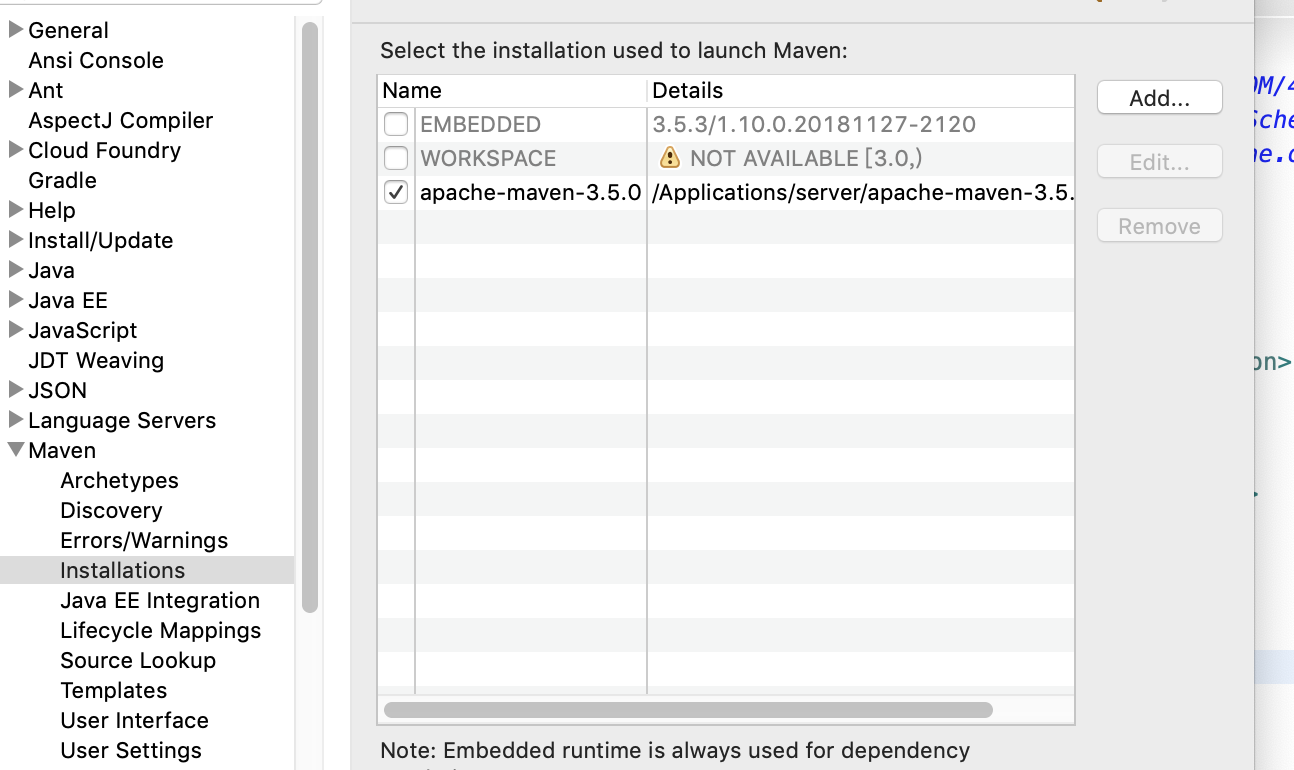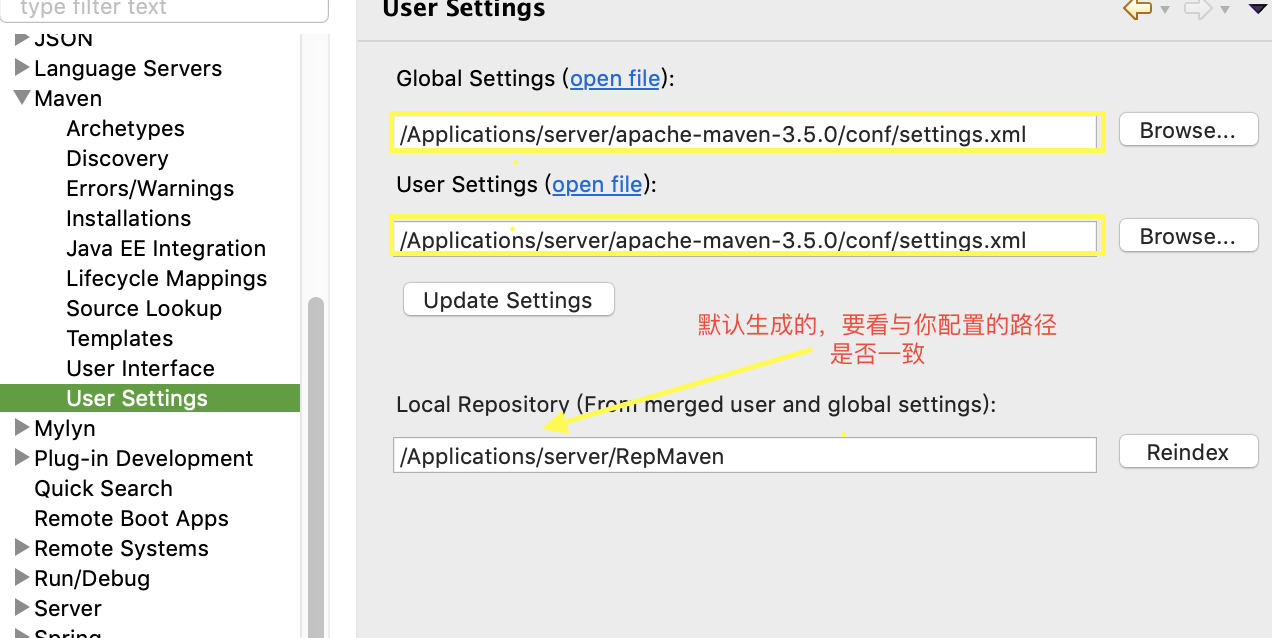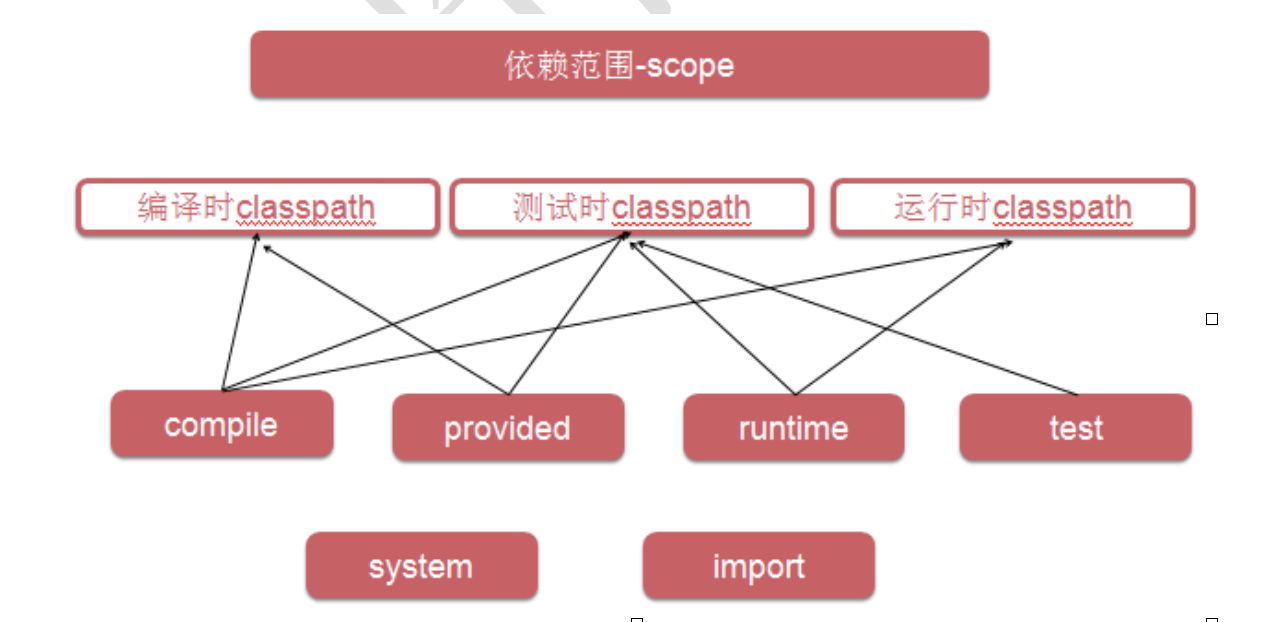一、STS集成maven(以下是mac版的STS)
1、点击Spring Tool Suite,点击preferences
maven中的installations
点击add,选择对应的路径即可

点击User Settings,

可以自行设置家目录的位置,要在settings.xml中进行配置
<?xml version="1.0" encoding="UTF-8"?> <!-- Licensed to the Apache Software Foundation (ASF) under one or more contributor license agreements. See the NOTICE file distributed with this work for additional information regarding copyright ownership. The ASF licenses this file to you under the Apache License, Version 2.0 (the "License"); you may not use this file except in compliance with the License. You may obtain a copy of the License at http://www.apache.org/licenses/LICENSE-2.0 Unless required by applicable law or agreed to in writing, software distributed under the License is distributed on an "AS IS" BASIS, WITHOUT WARRANTIES OR CONDITIONS OF ANY KIND, either express or implied. See the License for the specific language governing permissions and limitations under the License. --> <!-- | This is the configuration file for Maven. It can be specified at two levels: | | 1. User Level. This settings.xml file provides configuration for a single user, | and is normally provided in ${user.home}/.m2/settings.xml. | | NOTE: This location can be overridden with the CLI option: | | -s /path/to/user/settings.xml | | 2. Global Level. This settings.xml file provides configuration for all Maven | users on a machine (assuming they're all using the same Maven | installation). It's normally provided in | ${maven.home}/conf/settings.xml. | | NOTE: This location can be overridden with the CLI option: | | -gs /path/to/global/settings.xml | | The sections in this sample file are intended to give you a running start at | getting the most out of your Maven installation. Where appropriate, the default | values (values used when the setting is not specified) are provided. | |--> <settings xmlns="http://maven.apache.org/SETTINGS/1.0.0" xmlns:xsi="http://www.w3.org/2001/XMLSchema-instance" xsi:schemaLocation="http://maven.apache.org/SETTINGS/1.0.0 http://maven.apache.org/xsd/settings-1.0.0.xsd"> <!-- localRepository | The path to the local repository maven will use to store artifacts. | | Default: ${user.home}/.m2/repository <localRepository>/path/to/local/repo</localRepository> --> <localRepository>D:/RepMaven</localRepository> <!-- 设置家目录的位置 --> <!-- interactiveMode | This will determine whether maven prompts you when it needs input. If set to false, | maven will use a sensible default value, perhaps based on some other setting, for | the parameter in question. | | Default: true <interactiveMode>true</interactiveMode> --> <!-- offline | Determines whether maven should attempt to connect to the network when executing a build. | This will have an effect on artifact downloads, artifact deployment, and others. | | Default: false <offline>false</offline> --> <!-- pluginGroups | This is a list of additional group identifiers that will be searched when resolving plugins by their prefix, i.e. | when invoking a command line like "mvn prefix:goal". Maven will automatically add the group identifiers | "org.apache.maven.plugins" and "org.codehaus.mojo" if these are not already contained in the list. |--> <pluginGroups> <!-- pluginGroup | Specifies a further group identifier to use for plugin lookup. <pluginGroup>com.your.plugins</pluginGroup> --> </pluginGroups> <!-- proxies | This is a list of proxies which can be used on this machine to connect to the network. | Unless otherwise specified (by system property or command-line switch), the first proxy | specification in this list marked as active will be used. |--> <proxies> <!-- proxy | Specification for one proxy, to be used in connecting to the network. | <proxy> <id>optional</id> <active>true</active> <protocol>http</protocol> <username>proxyuser</username> <password>proxypass</password> <host>proxy.host.net</host> <port>80</port> <nonProxyHosts>local.net|some.host.com</nonProxyHosts> </proxy> --> </proxies> <!-- servers | This is a list of authentication profiles, keyed by the server-id used within the system. | Authentication profiles can be used whenever maven must make a connection to a remote server. |--> <servers> <!-- server | Specifies the authentication information to use when connecting to a particular server, identified by | a unique name within the system (referred to by the 'id' attribute below). | | NOTE: You should either specify username/password OR privateKey/passphrase, since these pairings are | used together. | <server> <id>deploymentRepo</id> <username>repouser</username> <password>repopwd</password> </server> --> <!-- Another sample, using keys to authenticate. <server> <id>siteServer</id> <privateKey>/path/to/private/key</privateKey> <passphrase>optional; leave empty if not used.</passphrase> </server> --> </servers> <!-- mirrors | This is a list of mirrors to be used in downloading artifacts from remote repositories. | | It works like this: a POM may declare a repository to use in resolving certain artifacts. | However, this repository may have problems with heavy traffic at times, so people have mirrored | it to several places. | | That repository definition will have a unique id, so we can create a mirror reference for that | repository, to be used as an alternate download site. The mirror site will be the preferred | server for that repository. |--> <mirrors> <!-- mirror | Specifies a repository mirror site to use instead of a given repository. The repository that | this mirror serves has an ID that matches the mirrorOf element of this mirror. IDs are used | for inheritance and direct lookup purposes, and must be unique across the set of mirrors. | <mirror> <id>mirrorId</id> <mirrorOf>repositoryId</mirrorOf> <name>Human Readable Name for this Mirror.</name> <url>http://my.repository.com/repo/path</url> </mirror> --> <mirror> <id>alimaven</id> <mirrorOf>central</mirrorOf> <name>aliyun maven</name> <url>http://maven.aliyun.com/nexus/content/groups/public</url> </mirror> <mirror> <id>repo2</id> <mirrorOf>central</mirrorOf> <name>repo2 maven</name> <url>http://repo2.maven.org/maven2</url> </mirror> <!--设置默认在阿里巴巴的maven镜像中下载--> <mirror> <id>uk</id> <mirrorOf>central</mirrorOf> <name>Human Readable Name for this Mirror.</name> <url>http://uk.maven.org/maven2</url> </mirror> <mirror> <id>nexus</id> <mirrorOf>central</mirrorOf> <name>internal nexus repository</name> <url>http://repo.maven.apache.org/maven2</url> </mirror> </mirrors> <!-- profiles | This is a list of profiles which can be activated in a variety of ways, and which can modify | the build process. Profiles provided in the settings.xml are intended to provide local machine- | specific paths and repository locations which allow the build to work in the local environment. | | For example, if you have an integration testing plugin - like cactus - that needs to know where | your Tomcat instance is installed, you can provide a variable here such that the variable is | dereferenced during the build process to configure the cactus plugin. | | As noted above, profiles can be activated in a variety of ways. One way - the activeProfiles | section of this document (settings.xml) - will be discussed later. Another way essentially | relies on the detection of a system property, either matching a particular value for the property, | or merely testing its existence. Profiles can also be activated by JDK version prefix, where a | value of '1.4' might activate a profile when the build is executed on a JDK version of '1.4.2_07'. | Finally, the list of active profiles can be specified directly from the command line. | | NOTE: For profiles defined in the settings.xml, you are restricted to specifying only artifact | repositories, plugin repositories, and free-form properties to be used as configuration | variables for plugins in the POM. | |--> <profiles> <profile> <id>jdk-1.8</id> <activation> <activeByDefault>true</activeByDefault> <jdk>1.8</jdk> </activation> <properties> <maven.compiler.source>1.8</maven.compiler.source> <maven.compiler.target>1.8</maven.compiler.target> <maven.compiler.compilerVersion>1.8</maven.compiler.compilerVersion> </properties> </profile> <!--设置jdk的默认环境为jdk1.8.不设置默认是1。5--> <!-- profile | Specifies a set of introductions to the build process, to be activated using one or more of the | mechanisms described above. For inheritance purposes, and to activate profiles via <activatedProfiles/> | or the command line, profiles have to have an ID that is unique. | | An encouraged best practice for profile identification is to use a consistent naming convention | for profiles, such as 'env-dev', 'env-test', 'env-production', 'user-jdcasey', 'user-brett', etc. | This will make it more intuitive to understand what the set of introduced profiles is attempting | to accomplish, particularly when you only have a list of profile id's for debug. | | This profile example uses the JDK version to trigger activation, and provides a JDK-specific repo. <profile> <id>jdk-1.4</id> <activation> <jdk>1.4</jdk> </activation> <repositories> <repository> <id>jdk14</id> <name>Repository for JDK 1.4 builds</name> <url>http://www.myhost.com/maven/jdk14</url> <layout>default</layout> <snapshotPolicy>always</snapshotPolicy> </repository> </repositories> </profile> --> <!-- | Here is another profile, activated by the system property 'target-env' with a value of 'dev', | which provides a specific path to the Tomcat instance. To use this, your plugin configuration | might hypothetically look like: | | ... | <plugin> | <groupId>org.myco.myplugins</groupId> | <artifactId>myplugin</artifactId> | | <configuration> | <tomcatLocation>${tomcatPath}</tomcatLocation> | </configuration> | </plugin> | ... | | NOTE: If you just wanted to inject this configuration whenever someone set 'target-env' to | anything, you could just leave off the <value/> inside the activation-property. | <profile> <id>env-dev</id> <activation> <property> <name>target-env</name> <value>dev</value> </property> </activation> <properties> <tomcatPath>/path/to/tomcat/instance</tomcatPath> </properties> </profile> --> </profiles> <!-- activeProfiles | List of profiles that are active for all builds. | <activeProfiles> <activeProfile>alwaysActiveProfile</activeProfile> <activeProfile>anotherAlwaysActiveProfile</activeProfile> </activeProfiles> --> </settings>
配置pom.xml
<!--依赖--> <dependencies> <dependency> <groupId>junit</groupId> <artifactId>junit</artifactId> <version>4.10</version> <scope>test</scope> </dependency> </dependencies>
使用酷站:https://mvnrepository.com/artifact/org.springframework/spring-core/4.0.0.RELEASE
直接粘贴
1 <!-- https://mvnrepository.com/artifact/org.springframework/spring-core --> 2 <dependency> 3 <groupId>org.springframework</groupId> 4 <artifactId>spring-core</artifactId> 5 <version>4.0.0.RELEASE</version> 6 </dependency>
第九章依赖管理
9.1 基本概念
当A jar包需要用到B jar包中的类时,我们就说A对B有依赖。例如:commons-fileupload-1.3.jar依赖于commons-io-2.0.1.jar。
通过第二个Maven工程我们已经看到,当前工程会到本地仓库中根据坐标查找它所依赖的jar包。
配置的基本形式是使用dependency标签指定目标jar包的坐标。例如:
<dependencies> <dependency> <!—坐标 --> <groupId>junit</groupId> <artifactId>junit</artifactId> <version>4.10</version> <!-- 依赖的范围 --> <scope>test</scope> </dependency> </dependencies>
注意:A依赖于B,B不能依赖A,否则会死循环(不能围成圈)
9.2 直接依赖和间接依赖
如果A依赖B,B依赖C,那么A→B和B→C都是直接依赖,而A→C是间接依赖。
9.3 依赖的范围
<scope>compile</scope>
当一个Maven工程添加了对某个jar包的依赖后,这个被依赖的jar包可以对应下面几个可选的范围:
①compile(开发/测试/部署/运行都能用)
[1]main目录下的Java代码可以访问这个范围的依赖
[2]test目录下的Java代码可以访问这个范围的依赖
[3]部署到Tomcat服务器上运行时要放在WEB-INF的lib目录下
例如:对Hello的依赖。主程序、测试程序和服务器运行时都需要用到。
②test(开发/部署/运行不用,测试用)
[1]main目录下的Java代码不能访问这个范围的依赖
[2]test目录下的Java代码可以访问这个范围的依赖
[3]部署到Tomcat服务器上运行时不会放在WEB-INF的lib目录下
例如:对junit的依赖。仅仅是测试程序部分需要。
③provided
[1]main目录下的Java代码可以访问这个范围的依赖
[2]test目录下的Java代码可以访问这个范围的依赖
[3]部署到Tomcat服务器上运行时不会放在WEB-INF的lib目录下
例如:servlet-api在服务器上运行时,Servlet容器会提供相关API,所以部署的时候不需要。
④runtime[了解]
[1]main目录下的Java代码不能访问这个范围的依赖
[2]test目录下的Java代码可以访问这个范围的依赖
[3]部署到Tomcat服务器上运行时会放在WEB-INF的lib目录下
例如:JDBC驱动。只有在测试运行和在服务器运行的时候才决定使用什么样的数据库连接。
⑤其他:import、system等。
各个依赖范围的作用可以概括为下图:

9.4 依赖的传递性
当存在间接依赖的情况时,主工程对间接依赖的jar可以访问吗?这要看间接依赖的jar包引入时的依赖范围——只有依赖范围为compile时可以访问。例如:

9.5 依赖的原则:解决jar包冲突
①路径最短者优先

②路径相同时先声明者优先

这里“声明”的先后顺序指的是dependency标签配置的先后顺序。
9.6 依赖的排除
有的时候为了确保程序正确可以将有可能重复的间接依赖排除。请看如下的例子:
●假设当前工程为survey_public,直接依赖survey_environment。
●survey_environment依赖commons-logging的1.1.1对于survey_public来说是间接依赖。
●当前工程survey_public直接依赖commons-logging的1.1.2
●加入exclusions配置后可以在依赖survey_environment的时候排除版本为1.1.1的commons-logging的间接依赖
<dependency> <groupId>com.atguigu.maven</groupId> <artifactId>Survey160225_4_Environment</artifactId> <version>0.0.1-SNAPSHOT</version> <!-- 依赖排除 --> <exclusions> <exclusion> <groupId>commons-logging</groupId> <artifactId>commons-logging</artifactId> </exclusion> </exclusions> </dependency> <dependency> <groupId>commons-logging</groupId> <artifactId>commons-logging</artifactId> <version>1.1.2</version> </dependency>
9.7 统一管理目标jar包的版本
以对Spring的jar包依赖为例:Spring的每一个版本中都包含spring-core、spring-context等jar包。我们应该导入版本一致的Spring jar包,而不是使用4.0.0的spring-core的同时使用4.1.1的spring-context。
<dependency> <groupId>org.springframework</groupId> <artifactId>spring-core</artifactId> <version>4.0.0.RELEASE</version> </dependency> <dependency> <groupId>org.springframework</groupId> <artifactId>spring-context</artifactId> <version>4.0.0.RELEASE</version> </dependency> <dependency> <groupId>org.springframework</groupId> <artifactId>spring-jdbc</artifactId> <version>4.0.0.RELEASE</version> </dependency> <dependency> <groupId>org.springframework</groupId> <artifactId>spring-orm</artifactId> <version>4.0.0.RELEASE</version> </dependency> <dependency> <groupId>org.springframework</groupId> <artifactId>spring-web</artifactId> <version>4.0.0.RELEASE</version> </dependency> <dependency> <groupId>org.springframework</groupId> <artifactId>spring-webmvc</artifactId> <version>4.0.0.RELEASE</version> </dependency>
问题是如果我们想要将这些jar包的版本统一升级为4.1.1,是不是要手动一个个修改呢?显然,我们有统一配置的方式:
<properties> <spring.version>4.1.1.RELEASE</spring.version> </properties> …… <dependency> <groupId>org.springframework</groupId> <artifactId>spring-core</artifactId> <version>${spring.version}</version> </dependency> <dependency> <groupId>org.springframework</groupId> <artifactId>spring-context</artifactId> <version>${spring.version}</version> </dependency> <dependency> <groupId>org.springframework</groupId> <artifactId>spring-jdbc</artifactId> <version>${spring.version}</version> </dependency> <dependency> <groupId>org.springframework</groupId> <artifactId>spring-orm</artifactId> <version>${spring.version}</version> </dependency> <dependency> <groupId>org.springframework</groupId> <artifactId>spring-web</artifactId> <version>${spring.version}</version> </dependency> <dependency> <groupId>org.springframework</groupId> <artifactId>spring-webmvc</artifactId> <version>${spring.version}</version> </dependency>
这样一来,进行版本调整的时候只改一改地方就行了。